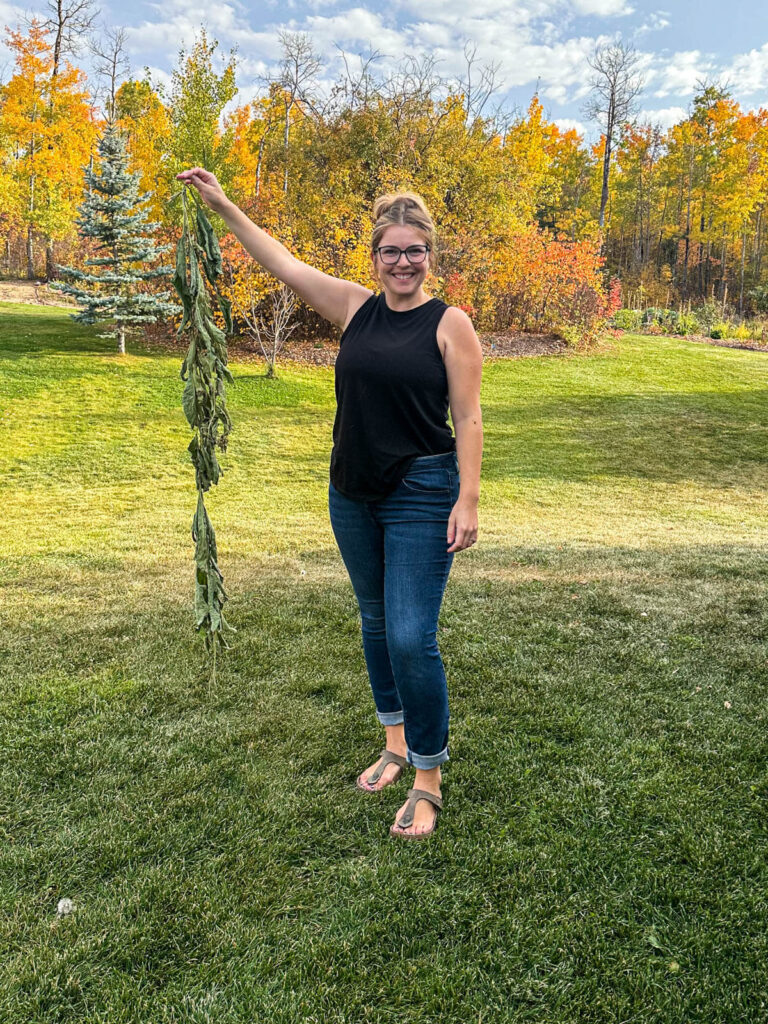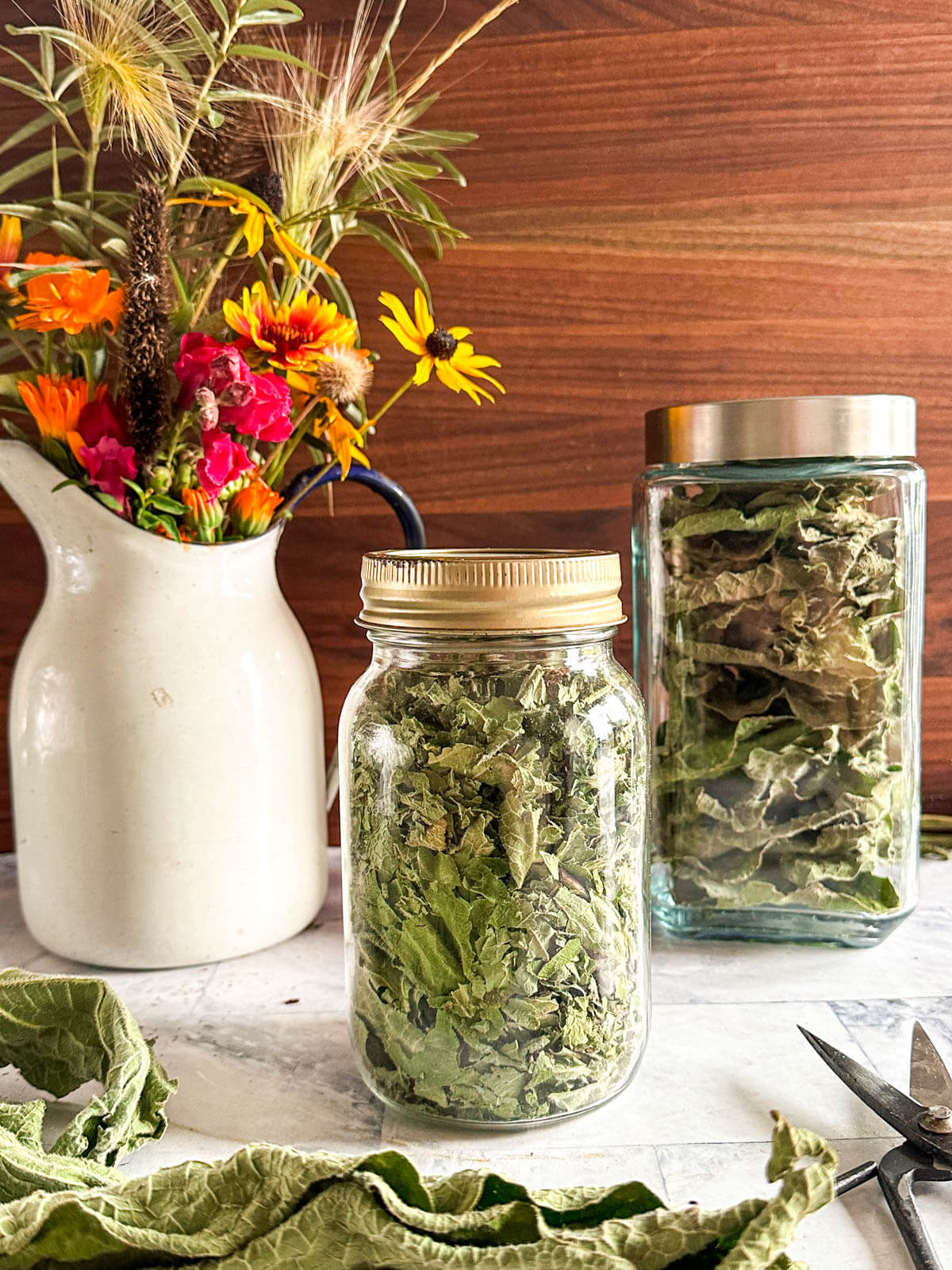Now that youve planted root cuttings, waited the entire season, and harvested comfrey leaves, its time to dry them!
The drying process is essential as it not only preserves your harvest for future use but also concentrates the beneficial compounds found in comfrey leaves. Whether youre planning to use them for a homemade salve or a nutrient-rich plant feed, properly dried leaves are key.
Comfrey (Symphytum spp.) is a cold hardy perennial herb native to Europe and parts of Asia. Its been introduced in North America as an ornamental. Its known for its beautiful bell-shaped flowers that can range in color from cream, pink, and blue to purplish-blue, depending on the variety.
The plant typically grows between 2 to 5 feet tall, and it has hairy and angular stems. The leaves are large and broad at the base, getting smaller as they go up the stem. They are usually dark green on the top and lighter underneath, with a rough, hairy texture.
Comfrey is also recognized for its thick root. This root system is vigorous and allows the plant to thrive in a wide range of soil types, although it prefers rich, moist soil. It also allows the plant to reproduce via root cuttings and crown divisions.
One of the most notable characteristics of comfrey is its use in herbal medicine. The plant has been used in traditional medicine since at least the 16th century, particularly for its ability to heal wounds and broken bones. However, its important to note that oral consumption is generally not recommended due to the presence of certain toxic compounds that can affect the liver over time.
Comfrey is also often used in organic gardening and permaculture practices as it is believed to be a dynamic accumulator. Its leaves are a rich source of nutrients and can be used to make an excellent fertilizer and additions to the compost pile.
Many people practice chop and drop mulching which is a lot like comfrey compost, allowing the leaves to decompose in place around the plants in their food forests and forest gardens to return the nutrients to the surface level for use by microbes in the soil. While others use the large leaves to make comfrey tea fertilizers to feed plants liquid nutrients.
No matter the herbal benefits of comfrey, it should NOT be ingested. It contains pyrrolizidine alkaloids which can cause liver toxicity and that is the absolute opposite of what we want as people who turn to natural healing. Use caution and research before using comfrey in your own home.
Once the plant reaches 2 feet tall, snip large leaves near the base of the plant, leaving smaller furled leaves intact for the plant to continue photosynthesizing.
Comfrey should be harvested in early – mid September, before the first hard frost 28F or -3C.
Comfrey is an amazing herbaceous plant that has many uses. The leaves and roots can be used medicinally, the leaves make excellent fertilizer and compost activator, and comfrey attracts pollinators to the garden. With proper drying techniques, you can preserve comfrey leaves for year-round use.
Why Dry Comfrey Leaves?
There are several benefits to drying comfrey leaves:
-
Provides comfrey for use during winter or other seasons when it is not growing.
-
Makes comfrey easier to store long-term Fresh leaves have high moisture content.
-
Allows leaves to be used for making infused herbal oils salves, liniments and more. These all require dried plant material.
-
Dried leaves can be used as a nutritious feed supplement for chickens and other livestock during winter
-
Dried leaves are better for using as a garden fertilizer compared to fresh, as they won’t take root and spread.
When to Harvest Comfrey Leaves
-
Harvest comfrey leaves several times per growing season. Generally harvest when the plant is at least 2 feet tall.
-
Cut leaves in the morning after dew has dried to avoid excess moisture.
-
Use clean, sharp pruners or scissors to cut each leaf near the base of the plant. Avoid bruising.
-
For best quality, select leaves that are vibrant green and free of holes, dirt or damage.
Drying Methods for Comfrey Leaves
There are several effective techniques for drying comfrey leaves:
Air Drying
This method involves hanging whole leaves or bundles of leaves upside down in a dry, well-ventilated area out of direct sunlight. Air circulation speeds drying. Bring indoors at night if dew is an issue. Takes 1-2 weeks to fully dry.
Screens
Lay leaves flat in a single layer on mesh screens. Allows good airflow. Can dry outdoors in shade or indoors near a fan. Takes 3-7 days.
Dehydrator
Place leaves in single layer on dehydrator trays. Use lowest temperature setting. Rotate trays and check frequently. Takes 1-3 days.
Oven
Arrange leaves on trays and dry at lowest oven temperature setting with door propped open. Rotate trays and monitor closely to prevent scorching. Takes 1-3 days.
How to Tell When Comfrey is Dry
Properly dried comfrey leaves are brittle and crumble easily when crushed. No moisture should be left. Signs leaves are fully dried:
-
Crumble easily in your hands
-
No moisture accumulates when leaves are sealed in a glass jar for 1-2 days
-
Stems break cleanly rather than bending
-
Grayish-green color
Storing Dried Comfrey Leaves
-
Place thoroughly dried leaves in airtight glass jars or resealable plastic bags.
-
Store in a cool, dark place. Dried comfrey will keep for 1-2 years.
-
If leaves show moisture, additional drying time is needed before storage.
Uses for Dried Comfrey Leaves
Dried comfrey has many uses:
-
Make comfrey oil infusions for salves, creams or liniments
-
Use as a mineral-rich feed supplement for chickens and livestock
-
Add to compost piles as an activator
-
Make garden fertilizer or mulch from leaves
-
Use for poultices to treat sprains, swelling and bruises
-
Blend dried leaves into a powder to sprinkle on wounds
-
Prepare healing comfrey teas and tinctures (use caution internally)
Drying comfrey leaves at harvest enables you to benefit from comfrey’s healing properties all year long. With proper storage, dried leaves will retain their potency for use when you need them.

Air Drying Comfrey Leaves
This low-tech method is a great way to dry the leaves, though the better the airflow, the quicker the leaves will dry.
We used a string and needle and threaded each comfrey leaf through the stem, then looped the thread around the stem to lock it into place, aiming to separate the leaves by at least 8 inches.
Then we got creative and started hanging the threads anywhere with good airflow, including the garage door rails, the sides on my plant stand, and even the shower rod in the garage bathroom.
Alternatively, you can thread the fresh leaves on a string and hang like bunting.
We allowed the leaves to dry for 4-6 days, or until they are dry and brittle.


Storing Dried Comfrey Leaves
Leaves can be left whole or crushed before placing in jars. Large leaves are better suited to compresses and poultices, while ground leaves are better for infused oils and salves.
Store your dried leaves in tightly sealed glass jars or other air-tight containers in a cool, dark space, away from direct sunlight until youre ready to use them.
When properly stored, the leaves should last at least 1 year, but should be used sooner than later for the highest quality.

Dried comfrey has many herbal uses;
COMFREY – 2 LEAVES FRESH = ?? TBSP DRIED (OAG)
FAQ
What should you not do with comfrey?
- Do not use comfrey on any type of broken or irritated skin.
- Do not use if pregnant, even for external use.
- Avoid it if you have liver problems or cancer.
- Do not use comfrey in combinations with anything else that affects the liver, such as pain relievers, alcohol, and prescription medications
How long will dried comfrey last?
If the product is left in hot places or open to sunlight then it will degrade much quicker than if it was stored in cool, dry place & sealed tightly. A good rule of thumb is that herbs should be stored no longer than 2-3 years but many herbs will have great strength much longer than that.
How do you harvest comfrey for medicinal use?
How to harvest comfrey. Use secateurs or hand shears to cut stems close to the base of the plant – a height of about 2 inches above the soil level is usually safe, making sure you do not damage new shoots.
How do you process comfrey leaves?
Place the leaves in the bin, chop with shears, and then press own with a weight. (we use a couple of bricks in a bucket) and allow the leaves to rot of their own accord, catching drips of this precious black liquid, which should be used sparingly. Use in a ratio of one-part feed to ten parts water.
